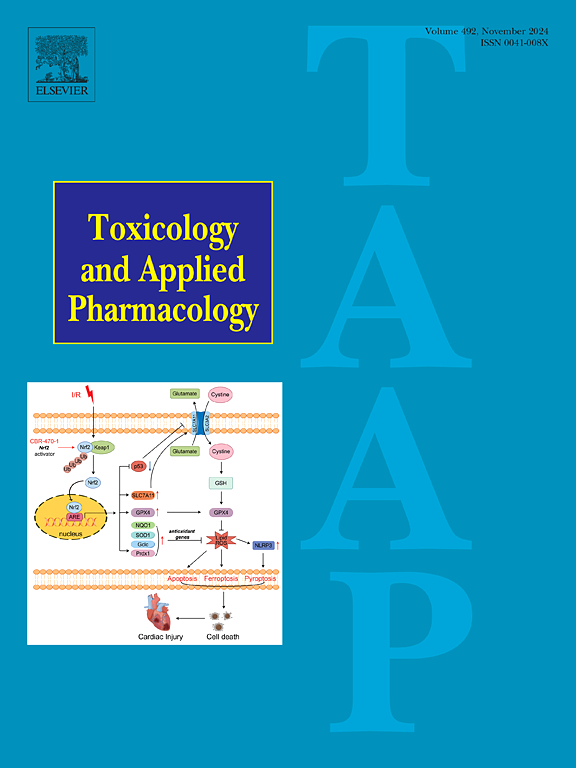Protective effect of thymoquinone against doxorubicin-induced cardiotoxicity and the underlying mechanism
IF 3.3
3区 医学
Q2 PHARMACOLOGY & PHARMACY
引用次数: 0
Abstract
Background
Ferroptosis is a key process in doxorubicin (DOX)-induced cardiotoxicity and is a potentially important therapeutic target. Thymoquinone (TQ) is a monoterpenoid compound isolated from black cumin extract that exhibits antitumor effects and acts as a powerful mitochondrial-targeted antioxidant. In this study, we investigated the effect of TQ on DOX-induced cardiotoxicity and the potential underlying mechanisms.
Methods and results
Mice were randomly assigned to the control (CON) group, DOX (20 mg/kg) group, TQ10 (10 mg/kg/d) group, and TQ20 (20 mg/kg/d) group and intraperitoneally injected with DOX and different doses of TQ. The electrocardiogram, blood pressure, and cardiac ultrasound changes during the experiments showed that TQ exerted a protective effect against DOX-induced cardiotoxicity. The glutathione (GSH), malondialdehyde (MDA), and total antioxidant capacity (T-AOC) levels in the mouse heart tissue were significantly different from those in the CON group. Western blot analysis revealed that the expression of nuclear factor E2-related factor 2 (Nrf2), heme oxygenase-1 (HO-1), glutathione peroxidase 4 (GPX4), and ferritin heavy chain 1 (FTH1) in the DOX group was lower than that in the control group. TQ treatment decreased these changes, indicating that TQ alleviated DOX-induced cardiotoxicity and increased the antioxidant capacity of murine cardiomyocytes. The mechanism might involve activating the Nrf2/HO-1 signaling pathway and reducing iron-mediated death. Immunohistochemical staining revealed similar effects on the expression levels of NQO1, COX-2, and NOX4. Moreover, transmission electron microscopy indicated that TQ protected murine cardiomyocytes against DOX-induced mitochondrial damage.
Conclusion
The results of this study suggested that TQ can decrease oxidative stress levels and DOX-induced cardiotoxicity by activating the Nrf2/HO-1 signaling pathway to alleviate ferroptosis in murine cardiomyocytes.
百里醌对阿霉素诱导的心脏毒性的保护作用及其机制。
背景:铁下沉是阿霉素(DOX)诱导的心脏毒性的一个关键过程,是一个潜在的重要治疗靶点。百里醌(TQ)是一种从黑孜然提取物中分离出来的单萜类化合物,具有抗肿瘤作用,是一种强大的线粒体靶向抗氧化剂。在这项研究中,我们研究了TQ对dox诱导的心脏毒性的影响及其潜在的机制。方法与结果:将小鼠随机分为对照组(CON)、DOX(20 mg/kg)组、TQ10(10 mg/kg/d)组和TQ20(20 mg/kg/d)组,分别腹腔注射DOX和不同剂量的TQ。实验期间的心电图、血压和心脏超声变化表明,TQ对dox诱导的心脏毒性具有保护作用。小鼠心脏组织中谷胱甘肽(GSH)、丙二醛(MDA)和总抗氧化能力(T-AOC)水平与CON组有显著差异。Western blot分析显示,DOX组核因子e2相关因子2 (Nrf2)、血红素加氧酶-1 (HO-1)、谷胱甘肽过氧化物酶4 (GPX4)、铁蛋白重链1 (FTH1)的表达低于对照组。TQ处理降低了这些变化,表明TQ减轻了dox诱导的心脏毒性,增加了小鼠心肌细胞的抗氧化能力。其机制可能涉及激活Nrf2/HO-1信号通路,减少铁介导的死亡。免疫组化染色显示NQO1、COX-2和NOX4的表达水平也有类似的影响。此外,透射电镜显示,TQ可以保护小鼠心肌细胞免受dox诱导的线粒体损伤。结论:TQ可通过激活Nrf2/HO-1信号通路,降低氧化应激水平和dox诱导的心脏毒性,减轻小鼠心肌细胞铁凋亡。
本文章由计算机程序翻译,如有差异,请以英文原文为准。
求助全文
约1分钟内获得全文
求助全文
来源期刊
CiteScore
6.80
自引率
2.60%
发文量
309
审稿时长
32 days
期刊介绍:
Toxicology and Applied Pharmacology publishes original scientific research of relevance to animals or humans pertaining to the action of chemicals, drugs, or chemically-defined natural products.
Regular articles address mechanistic approaches to physiological, pharmacologic, biochemical, cellular, or molecular understanding of toxicologic/pathologic lesions and to methods used to describe these responses. Safety Science articles address outstanding state-of-the-art preclinical and human translational characterization of drug and chemical safety employing cutting-edge science. Highly significant Regulatory Safety Science articles will also be considered in this category. Papers concerned with alternatives to the use of experimental animals are encouraged.
Short articles report on high impact studies of broad interest to readers of TAAP that would benefit from rapid publication. These articles should contain no more than a combined total of four figures and tables. Authors should include in their cover letter the justification for consideration of their manuscript as a short article.

 求助内容:
求助内容: 应助结果提醒方式:
应助结果提醒方式:


